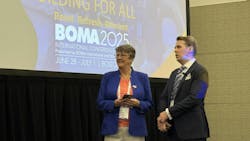Why Universal Design Is a Smart Move for Building Owners (BOMA 2025)
“Disability touches all of us. Whether it’s yourself, a friend, a loved one, or a colleague—it’s also a group many of us are likely to be part of one day as we age.”
That was the message Roman Romanov, director of Disability Advisory Services at the Rick Hansen Foundation, offered attendees at the onset of his presentation with Kim Saunders, a professional accessibility assessor from St. John’s, Newfoundland, at the 2025 BOMA International Conference & Expo in Boston. Their joint session titled, “Meaningful Accessibility: Improve the Performance of Your Building for All,” offered a powerful reminder to those in attendance about the fact that accessibility is not just about compliance—it’s about creating meaningful, inclusive experiences for everyone.
Why Accessibility Matters
Accessibility impacts more people than most realize and has a direct impact on the built environment. Romanov opened the session by highlighting the following statistics:
- 20% of Americans and 1.6 billion people globally live with a disability.
- 27% of the global consumer market is made up of individuals with disabilities.
- When you include friends and family members, 63% of the population is affected by accessibility.
He pointed out that when we design with inclusivity in mind, it helps ensure that everyone can participate in public life safety and with a greater sense of equity. “People are denied access to the places they live, work, learn, and play because of poor design,” Romanov said. “This isn’t just a barrier—it’s a missed opportunity.”
The numbers support his assertion, noting that the global disability market is currently valued at $18.3 trillion, and people with disabilities in the U.S. alone control $1.3 trillion in disposable income. “Accessibility is not a ‘nice to have’—it improves your overall business operations,” Romanov added.
Designing for Meaningful Access That Goes Beyond ADA
Traditional requirements like the Americans with Disabilities Act (ADA) provide minimum standards and are an essential part of ensuring access to buildings for people of varying abilities. But true accessibility goes far beyond the bare minimum, Romanov said. Citing the Rick Hansen Foundation’s definition of “meaningful access,” he explained that it’s about design that considers a user’s entire journey through a building, from arrival to departure, and trying to anticipate the needs of all users regardless of their ability.
Saunders then explained how the concept of Universal Design (UD) provides the framework for this philosophy, a phrase coined by architect Ron Mace that describes the practice of designing environments to be usable by all people, to the greatest extent possible, without the need for adaptation. As Saunders noted, “This is not a special requirement for a minority—it’s a fundamental condition of good design.”
The 7 Principles of Universal Design
Saunders walked attendees through the seven guiding principles behind Universal Design, which include:
- Equitable use
- Flexibility in use
- Simple and intuitive use
- Perceptible information
- Tolerance for error
- Low physical effort
- Size and space for approach and use
She then discussed the Rick Hansen Foundation Accessibility Certification™ (RHFAC), a third-party rating system that helps building owners understand how well their properties support accessibility—not just by code, but by the Universal Design principles identified above.
“It’s like LEED or WELL, but for physical access,” Saunders explained. “You get a score that tells you what you’re doing well, where you’re falling short, and how to improve.”
What Accessibility Looks Like in Practice
What followed was a lively discussion in which the presenters and attendees alike shared from their lived experiences—including several in the audience that mentioned family members who live with disabilities—and how the built environment can be improved to be more accommodating and accessible for them. Throughout the session, attendees participated in interactive photo assessments using a mobile app to determine whether various building elements met accessibility standards. Here are a few key examples that stood out:
· Parking and Drop-Off Zones. Accessible parking spots were intentionally located directly in front of building entrances with clear high-contrast markings and access aisles. Vertical signage complemented painted markers in case of snow or low visibility.
· Building Entrances. Positive features included power door operators and flat, even surfaces. Opportunities for improvement included glazed doors without high-contrast markings and poorly located push buttons.
· Reception Desks. A universally accessible desk had a central lowered counter with frontal knee clearance and integrated hearing loop (T-coil) technology.
· Doors and Doorways. A poor example lacked contrast, vision panels, or assistive opening mechanisms. A better version had full-height vision panels, high-contrast color schemes, ergonomic handles, and vertical push bars that could be activated by hip, foot, or elbow.
· Restrooms Common pitfalls included unreachable grab bars, inaccessible flush mechanisms, and inadequate turning space. More accessible designs featured forward-approach sinks, backrests, tactile-friendly latches, and covered plumbing to avoid burns for those without sensation in their legs.
· Signage. Good signage was mounted on the latch side of the door, included tactile and raised characters, and was high contrast. Less effective signage was placed directly on doors or lacked pictograms, which are critical for users with cognitive or language-based impairments.
Real-World Impact: Case Studies
Saunders shared how two buildings she manages in St. John’s achieved Rick Hansen Foundation certification—one a new build and one a renovation.
Some impactful, low- or no-cost improvements that she and her team incorporated into these buildings included:
- Moving van-accessible parking to the correct side of the entrance
- Adding blade and directional signage throughout corridors
- Installing wave-activated entry door buttons
- Color-coded floor bands on glass walls to prevent collisions
- Relocating coat hooks and signage for better reach
- Providing varied seating in long hallways to support rest and transfer needs
“You don’t need a huge budget to make a big difference,” she noted. “Of the 99 features we evaluated, 65% cost $50,000 or less, and many cost nothing.”
Resources for Building Owners
To help owners and operators implement practical solutions that move toward “meaningful accessibility,” the Rick Hansen Foundation offers a free resource titled, “The Office Guide for Meaningful Access,” a comprehensive, 85-page manual outlining practical ways to improve accessibility based on RHF’s certification model.
“Accessibility isn’t perfection—it’s progress. The earlier you start, the more influence you have, and the less it will cost. And when you design for inclusion, you’re designing for your future self,” Roman concluded.

